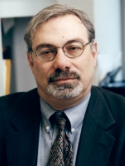17AAG: Low target binding affinity and potent cell activity - Finding an explanation Journal Article
| Authors: | Chiosis, G.; Huezo, H.; Rosen, N.; Mimnaugh, E.; Whitesell, L.; Neckers, L. |
| Article Title: | 17AAG: Low target binding affinity and potent cell activity - Finding an explanation |
| Abstract: | The ansamycin geldanamycin (GM) and its derivative, 17AAG, now in early clinical trials in cancer patients, have potent activity against several cancer cells at low nanomolar concentrations. The main target of these drugs is the molecular chaperone heat shock protein 90. Contrary to the high antitumor potency, the affinity of these drugs for the chaperone was determined to be ∼1 μM. We propose that this difference can partly be explained by the physicochemical characteristics of the ansamycins. GM and 17AAG accumulate in cells, producing higher intracellular concentrations than expected. We conclude that although apparent activity for ansamycins can be seen at low nanomolar concentration, their real activity correlates with the heat shock protein 90 binding affinity and is in the low micromolar concentration range. We suggest that in the clinic, micromolar concentrations of 17AAG must accumulate in the tumor cells to achieve antitumor effects in patients comparable with ones achieved in tissue culture settings. © 2003 American Association for Cancer Research. |
| Keywords: | mass spectrometry; metabolism; cell division; drug effect; tumor cells, cultured; enzyme inhibitor; protein serine threonine kinase; breast neoplasms; prostatic neoplasms; gene expression regulation; gene expression regulation, neoplastic; drug antagonism; cell culture; enzyme inhibitors; protein-serine-threonine kinases; breast tumor; prostate tumor; drug derivative; heat shock protein 90; quinone derivative; hsp90 heat-shock proteins; quinones; binding site; cell fractionation; binding sites; antibiotics, antineoplastic; antineoplastic antibiotic; subcellular fractions; benzoquinones; lactams, macrocyclic; rifabutin; geldanamycin; 17-(allylamino)-17-demethoxygeldanamycin; benzoquinone derivative; macrocyclic lactam; 17 allylamino 17 demethoxygeldanamycin; humans; human; male; female; article |
| Journal Title: | Molecular Cancer Therapeutics |
| Volume: | 2 |
| Issue: | 2 |
| ISSN: | 1535-7163 |
| Publisher: | American Association for Cancer Research |
| Date Published: | 2003-02-01 |
| Start Page: | 123 |
| End Page: | 129 |
| Language: | English |
| PUBMED: | 12589029 |
| PROVIDER: | scopus |
| DOI/URL: | |
| Notes: | Export Date: 12 September 2014 -- Source: Scopus |
Citation Impact
Related MSK Work





